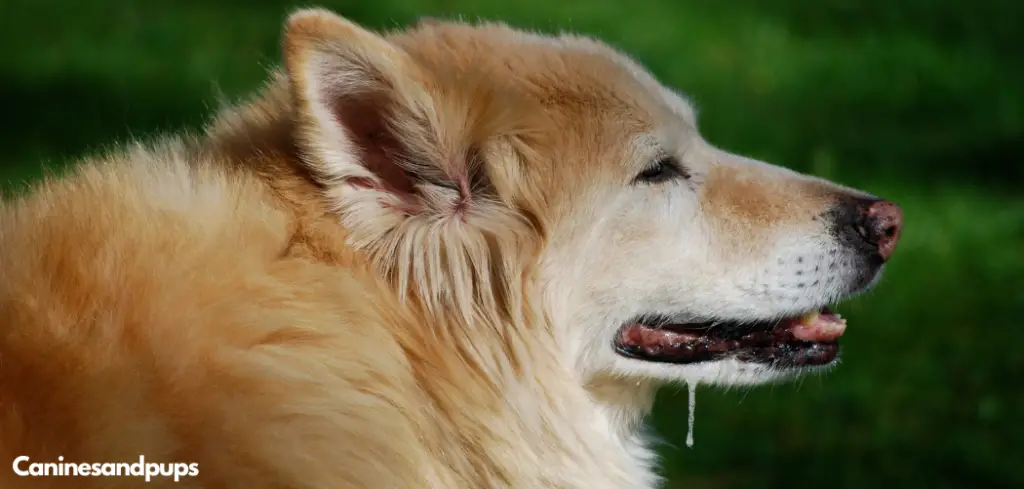It’s upsetting to see your dog panting excessively and appearing uncomfortable — especially if you suspect allergies might be the culprit.
We outline the connection between dog panting and allergies, what you can do at home, and when to seek veterinary help.
Table of Contents
Dog Panting and Allergies — Why It Happens
Panting related to allergies is more common than many dog owners realize. Allergies can trigger inflammation, itching, and respiratory discomfort — all of which may lead to panting. Dogs with seasonal allergies might pant due to skin irritation or congestion.
Food allergies and contact allergies can also make a dog feel agitated or hot, causing them to pant to self-soothe.
In some cases, allergic reactions can become serious and result in anaphylaxis, which causes intense panting, drooling, or collapse.

Understanding Dog Panting and Allergies
Seasonal Allergies
Dogs, like people, can be sensitive to pollen, grass, mold, or other airborne allergens — especially in the spring and summer months.
When these allergens are inhaled or absorbed through the skin, they can cause inflammation and discomfort. This irritation can make a dog pant, especially at night when allergens may accumulate indoors.
Owners may notice increased scratching, watery eyes, sneezing, or red skin alongside the panting.
Panting in these cases often reflects the dog’s overall discomfort and increased internal heat due to inflammation.
Read more: Dog Panting and Acting Weird at Night(Is it serious?)
Food Allergies
Certain ingredients in a dog’s diet — like chicken, beef, dairy, or wheat — can trigger allergic responses that go beyond just digestive upset.
In some dogs, food allergies manifest as itchy skin, ear infections, and agitation. That constant itching can cause panting, especially if the dog becomes restless or uncomfortable.
Owners may notice that the panting worsens after meals or during flare-ups of skin symptoms. A diet trial may be needed to identify the culprit.
Environmental Contact Allergies (Atopic Dermatitis)
If your dog lies on carpets recently cleaned with chemicals or rolls in grass treated with fertilizer or pesticides, they may experience allergic reactions through skin contact.
This reaction can cause red, inflamed skin, leading to itching, licking, and — you guessed it — panting. Dogs with atopic dermatitis often pant due to stress and the heat generated from the irritation.
Owners might also see inflamed paws, ear rubbing, or chewing at the skin, which all accompany the panting response.
Allergic Reactions (Acute or Anaphylactic)
Sometimes, a dog may encounter a sudden allergen — like a bee sting, certain medications, or a new food ingredient — that triggers an acute allergic reaction.
This type of reaction can escalate quickly, causing severe swelling, difficulty breathing, vomiting, and intense panting as the dog struggles to cope with internal inflammation.
This is a true emergency. Panting in this case is a red flag that the dog is in distress and may be heading into shock.
Secondary Infections from Allergies
When allergies are left untreated, the constant scratching and skin trauma can lead to bacterial or yeast infections.
These infections increase inflammation and discomfort, making the dog feel even more distressed. Panting may become chronic in these situations due to the ongoing pain and skin irritation.
You might notice foul-smelling skin, greasy patches, or oozing sores accompanying the panting behavior.
What to Do If Your Dog Is Panting and Allergies Are Suspected
First, try to determine what might be triggering the allergic reaction. If it’s seasonal, keeping your dog indoors during peak pollen times and wiping their paws after walks may help.
For food-related allergies, consult your vet about starting an elimination diet using hypoallergenic or novel proteins. Avoid giving your dog new treats without understanding the ingredients.
You can also use air purifiers inside your home, wash bedding frequently, and switch to fragrance-free cleaning products to minimize environmental allergens.
If your dog is panting and appears itchy, cool them down with a fan or cool, damp towel. A soothing oatmeal bath or veterinarian-recommended antihistamine (under vet guidance) may bring relief in mild cases.
Avoid over-the-counter human medications unless directed by a vet, as some can be toxic to dogs.
When to Call or Visit Your Vet
If your dog is panting heavily and seems lethargic, collapses, or shows signs of facial swelling or vomiting, it could be a life-threatening allergic reaction.
Get immediate veterinary attention if your dog has difficulty breathing, pale gums, or swelling around the eyes or muzzle.
If the panting is persistent, interferes with sleep, or your dog seems restless and itchy around the clock, your vet can help with allergy testing and long-term solutions.
Chronic ear infections, red or inflamed skin, or open sores due to scratching all indicate that professional treatment is necessary.
Early intervention can prevent worsening discomfort and the development of secondary infections.
Read more: Dog Panting and Agitated (What it means)
Key Takeaway
Panting in dogs can be a distressing symptom — and when linked to allergies, it often reflects inflammation, discomfort, or even a more serious reaction.
By identifying the root cause and managing allergens in your dog’s environment, you can help your pet breathe easier and feel more comfortable.
Always monitor for signs of serious allergic reactions and reach out to your vet if your dog’s symptoms escalate or don’t improve.
Your dog relies on you to notice the signs — and with the right care, most allergy-related panting can be effectively managed.
